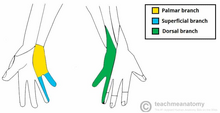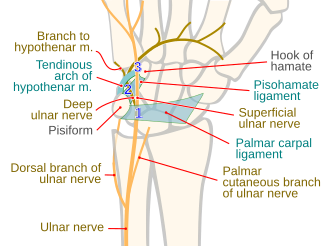| Ulnar tunnel syndrome | |
|---|---|
| Other names | Guyon's canal syndrome |
 | |
| Depiction of classic ulnar sensory distribution, including ulnar-4th and 5th fingers. Note that this diagram does not portray hand muscles affected by ulnar neuropathy. | |
| Specialty | Orthopedic surgery |
Ulnar tunnel syndrome, also known as Guyon's canal syndrome or Handlebar palsy, is ulnar neuropathy at the wrist where it passes through the Guyon canal.[1] The most common presentation is a palsy of the deep motor branch of the ulnar nerve causing weakness of the interosseous muscles. Many are associated with a ganglion cyst pressing on the ulnar nerve, but most are idiopathic. Long distance bicycle rides are associated with transient alterations in ulnar nerve function. [2] Sensory loss in the ring and small fingers is usually due to ulnar nerve entrapment at the cubital tunnel near the elbow, which is known as cubital tunnel syndrome, although it can uncommonly be due to compression at the wrist.
Causes[edit]
Ulnar neuropathy at the wrist is often associated with a mass such as a ganglion cyst or thrombosis or aneurysm of the ulnar artery.[3] The role of activities and exposure is less certain.
Diagnosis[edit]
Classification[edit]

Ulnar tunnel syndrome may be characterized by the location or zone within the Guyon's canal at which the ulnar nerve is compressed. The nerve divides into a superficial sensory branch and a deeper motor branch in this area. Thus, Guyon's canal can be separated into three zones based on which portion of the ulnar nerve are involved. The resulting syndrome results in either muscle weakness or impaired sensation in the ulnar distribution.[1]
| Location | Symptoms | Associations | |
| Zone 1 | Proximal (prior to ulnar nerve bifurcation) | Mixed motor & sensory | Ganglia & hook of hamate fractures |
| Zone 2 | Surrounding deep motor branch ulnar nerve | Motor only | Ganglia & hook of hamate fractures |
| Zone 3 | Surrounding superficial sensory branch of ulnar nerve | Sensory only | Ulnar artery pathology |
Zone 2 type syndromes are most common, while Zone 3 are least common.
Treatment[edit]
The role of gloves which help protect the ulnar nerve from compression is unclear. Palsy of the ulnar motor nerve isolated to the wrist is treated with operative decompression, often with concomitant ganglion excision. The surgery is to divide the volar carpal ligament which forms the roof of Guyon's canal, thereby reducing compression on the ulnar nerve.[4][5]
See also[edit]
References[edit]
- ^ a b Hatch, Daniel (August 20, 2014). "Ulnar Tunnel Syndrome". Orthobullets. Retrieved Sep 7, 2014.
- ^ Akuthota, V.; Plastaras, C.; Lindberg, K.; Tobey, J.; Press, J.; Garvan, C. (2005). "The effect of long-distance bicycling on ulnar and median nerves: an electrophysiologic evaluation of cyclist palsy". The American Journal of Sports Medicine. 33 (8): 1224–30. doi:10.1177/0363546505275131. PMID 16000656.
- ^ Depukat, Paweł; Mizia, Ewa; Kuniewicz, Marcin; Bonczar, Tomasz; Mazur, Małgorzata; Pełka, Piotr; Mróz, Izabela; Lipski, Marcin; Tomaszewski, Krzysztof (2015). "Syndrome of canal of Guyon - definition, diagnosis, treatment and complication". Folia Medica Cracoviensia. 55 (1): 17–23. ISSN 0015-5616. PMID 26774628.
- ^ Okutsu I, Hamanaka I, Yoshida A (April 2009). "Pre- and postoperative Guyon's canal pressure change in endoscopic carpal tunnel release: correlation with transient postoperative Guyon's canal syndrome". J Hand Surg Eur Vol. 34 (2): 208–11. doi:10.1177/1753193408100122. PMID 19282410.
- ^ Assmus H, Antoniadis G, Bischoff C, Hoffmann R, Martini AK, Preissler P, Scheglmann K, Schwerdtfeger K, Wessels KD, Wüstner-Hofmann M (May 2011). "Cubital tunnel syndrome - a review and management guidelines". Cent Eur Neurosurg. 72 (2): 90–8. doi:10.1055/s-0031-1271800. PMID 21547883.
Further reading[edit]
- Slane, Josh; Timmerman, Mark; Ploeg, Heidi-Lynn; Thelen, Darryl G. (2011). "The influence of glove and hand position on pressure over the ulnar nerve during cycling". Clinical Biomechanics. 26 (6): 642–8. doi:10.1016/j.clinbiomech.2011.03.003. PMID 21458120.
- Maimaris, C; Zadeh, H G (1990). "Ulnar nerve compression in the cyclist's hand: Two case reports and review of the literature". British Journal of Sports Medicine. 24 (4): 245–6. doi:10.1136/bjsm.24.4.245. PMC 1478904. PMID 2097022.
- Rehak, David C. (Summer 2003). "Cyclist's Hands: Overcoming overuse injuries". Hughston Health Alert. Hughston Clinic.
- Bledsoe, Jim. "Cycling injuries - handlebar palsy". Sports Injury Bulletin.
- US patent 6845514, Yao, Joseph, "Protective device for the median and ulnar nerves", issued January 25, 2005